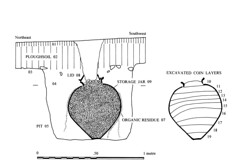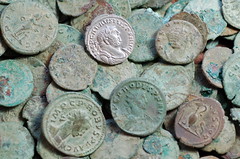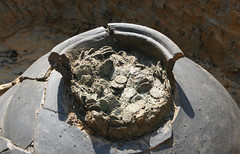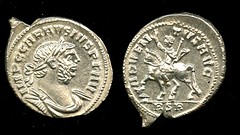Tony Williams, Coroner for Somerset, will hold an inquest on Thursday 22nd July on one of the largest Roman coin hoards ever found in Britain, the Portable Antiquities Scheme funded by the Museums, Libraries and Archive Council and Somerset County Council has reported.
Dave Crisp, found the hoard of some 52,500 coins dating to the 3rd century AD, while metal-detecting near Frome, and reported the find to his local Finds Liaison Officer. Initially Mr Crisp found 21 coins, but when he came across a pot filled with more knew he needed archaeological help to excavate them.



Images can be downloaded from our flickr account at www.flickr.com/finds/
Anna Booth, Somerset County Council’s Finds Liaison Officer, said:
Because Mr Crisp resisted the temptation to dig up the coins it has allowed archaeologists from Somerset County Council to carefully excavate the pot and its contents, ensuring important evidence about the circumstances of its burial was preserved”.
Mr Crisp added :
I knew the find was important and I needed archaeological help, so I contacted my local Finds Liaison Officer. I have made many finds over the years, but this is my first coin hoard and it was a fascinating experience to take part in the excavation of it.”
Archaeologists believe the hoard, which sheds light on the economic crisis and coalition government in the 3rd century, will rewrite the history books. One of the most important aspects of the hoard is that it contains a large group of coins of Carausius, who ruled Britain independently from AD 286 to AD 293 and was the first Roman emperor to strike coins in Britain. The hoard contains over 760 of his coins, making it the largest group of his coins ever found. Amongst these coins are five rare examples of his silver denarii, the only coins of their type being struck anywhere in the Roman Empire at the time.
The coins span 40 years from AD 253 to 293 and the great majority are of the denomination known as ‘radiates’, made of debased silver or bronze.
The hoard is probably the equivalent of about four years’ pay for a legionary soldier.
Roger Bland, Head of Portable Antiquities and Treasure at the British Museum said:
This hoard, which is one of the largest ever found in Britain, has a huge amount to tell about the coinage and history of the period as we study over the next two years. The late 3rd century AD was a time when Britain suffered barbarian invasions, economic crises and civil wars. Roman rule was finally stabilised when the Emperor Diocletian formed a coalition with the Emperor Maximian, which lasted 20 years. This defeated the separatist régime which had been established in Britain by Carausius. This find presents us with an opportunity to put Carausius on the map. School children across the country have been studying Roman Britain for decades, but are never taught about Carausius – our lost British emperor”.
If the hoard is declared Treasure by the coroner, it is hoped it will be acquired by Somerset County Council’s Heritage Service. Stephen Minnitt, Head of Museums at Somerset County Council, said:
This is a find of great national importance and we are determined to raise the sum to acquire the hoard for public benefit. Hopefully it will be able to go on display in the new Museum of Somerset when it re-opens in 2011”.
Ed Vaizey, Minister for Culture at the Department for Culture, Media and Sport said:
Once again this demonstrates how important the Treasure Act and the Portable Antiquities Scheme are in helping to preserve our heritage. I congratulate Mr Crisp on his prompt reporting of his find and especially in allowing archaeologists to excavate the hoard. If the hoard is declared Treasure, Somerset County Council Heritage Service will have the opportunity to acquire it at its full market value, as determined by an independent committee and that reward is shared by Mr Crisp and the owner of the land where the find was made. That way everyone is a winner.”
In the meantime the coins have been washed and stabilised by a team of conservators at the British Museum, led by Pippa Pearce, and they are being studied by Roger Bland and the Portable Antiquities Scheme’s Roman coins specialist, Sam Moorhead. The British Museum is actively seeking funds to clean the coins fully: this will be a year’s work for one conservator.
A selection of coins from the hoard will be on display in Gallery 68 at the British Museum from Thursday 22nd July until mid-August. The Portable Antiquities Scheme is a voluntary scheme managed by the British Museum on behalf of the Museums Libraries and Archives Council (MLA) and is funded through Renaissance, a programme to transform England’s regional museums.
For further details, including a full account of the discovery, images of the excavation and of the coins and a video of the removal of the coins from the pot see: www.finds.org.uk/fromehoard
For further information please contact:
Rebecca Musto PR and Communications Officer on 01823 355585 or email rmusto@somerset.gov.uk.
Roger Bland, Head of Portable Antiquities & Treasure, British Museum, 0798 966 9414, rbland@thebritishmuseum.ac.uk or Sam Moorhead, National Finds Adviser, Portable Antiquities Scheme, 0770 4677443, smoorhead@thebritishmuseum.ac.uk
Olivia Rickman, Press Manager, British Museum, 020 7323 8583, orickman@thebritishmuseum.ac.uk
Notes
Upon discovering the hoard Dave Crisp contacted Katie Hinds, Finds Liaison Officer for Wiltshire. MS Hinds then contacted Anna Booth, Somerset Finds Liaison Officer, who, with Somerset County Council archaeologists, set about the delicate task of excavating the pot and its contents. The hoard was then taken to the British Museum, so that the coins could be cleaned and recorded. This work was done within two months and represented about 400 hours’ work for the conservator team.
The coins all date from between AD 253 to AD 293 were found in a large, well-preserved pot – a type of container normally used for storing food – and weigh around 160kg. Since the pot containing the coins was found by the archaeologists to be already broken in the earth, the coins were removed from the pot in 12 layers, with each layer containing up to 16 separate bags of coins, a total of 67 separate groups in all.

Because of the weight of the coins and the fragility of the pot in which they were buried, the pot must have been buried in the ground before the coins were tipped into them. This suggests that this hoard is unlikely to have been buried because its owner (or owners) were concerned about the threat of invasion and, wishing to find a safe place to store their wealth, intended to come back and recover it later when the times were more peaceful. If that had been their intention, then they would have buried their coins in smaller containers which would have been easier to recover. The only way anyone could have recovered this hoard would have been by breaking the pot and scooping the coins out of it, which would have been awkward. It is thought therefore most likely that the person or persons who buried this hoard entrusted it to the earth without intending to come back and recover it later. Perhaps it was the offering of an agricultural community for a good harvest or favourable weather.
Each of the 67 groups of coins was washed and sorted separately and as a result we know that the great majority (85 per cent) of the coins of Carausius, the latest coins in the hoard, were contained within a single layer (Context 16). This gives us a fascinating insight into how the coins were placed in the pot, as a group of coins of Carausius must have been tipped into the pot separately from the rest of the coins.
Summary of the coins found in the hoard (note: these quantities are provisional and the final figures will change once the illegible coins have been cleaned and identified):
Central Empire
| Emperor | Reign | Quantity |
|---|---|---|
| Valerian & Gallienus (joint reign) | 253-60 | 46 |
| Gallienus (sole reign) | 260-8 | 6,091 |
| Salonina (wife of Gallienus) | 260-8 | 404 |
| Claudius II | 268-70 | 5,421 |
| Divus Claudius | 270-1 | 1,227 |
| Quintillus | 270 | 333 |
| Aurelian | 270-5 | 266 |
| Severina (wife of Aurelian) | 270-5 | 13 |
| Tacitus | 275-6 | 252 |
| Florian | 276 | 10 |
| Probus | 276-82 | 619 |
| Carus | 282-3 | 8 |
| Divus Carus | 283 | 5 |
| Magnia Urbica (wife of Carus) | 282-3 | 2 |
| Carinus | 282-5 | 19 |
| Numerian | 283-4 | 12 |
| Diocletian | 285-305 | 38 |
| Maximian | 286-305 | 22 |
| Total | Central Empire | 14,788 |
Gallic Empire
| Emperor | Reign | Quantity |
|---|---|---|
| Postumus | 260-9 | 257 |
| Laelian | 269 | 4 |
| Marius | 269 | 35 |
| Victorinus | 269-71 | 7,494 |
| Divus Victorinus | 271 | 14 |
| Tetricus I | 271-4 | 12,416 |
| Tetricus II | 272-4 | 5,203 |
| Gallic Empire | uncertain | 2,954 |
| Total | Gallic Empire | 28,377 |
British Empire
| Emperor | Reign | Quantity |
|---|---|---|
| Carausius | 286-93 | 766 |
Breakdown by identification status
| Status | Quantity |
|---|---|
| Contemporary copies | 314 |
| Identifiable coins | 44,245 |
| Illegible coins | 8,258 |
| Total | 52,503 |
The Portable Antiquities Scheme is a scheme to record archaeological objects found by the public, and to date over 570,000 finds have been recorded on its database (www.finds.org.uk). Its network of Finds Liaison Officers are the principal means by which new discoveries made by the public are reported to advance archaeological knowledge and our understanding of the past.
Under the 1996 Treasure Act, anyone who finds a group of coins buried together, or any artefact that is suspected to be 300 or more years old and has a 10 per cent gold or silver content, has a legal obligation to declare it to the local coroner within 14 days.